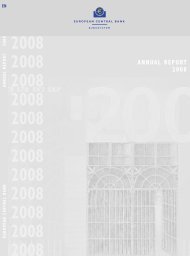Reserve Bank of Australia Annual Report 2011
Reserve Bank of Australia Annual Report 2011
Reserve Bank of Australia Annual Report 2011
Create successful ePaper yourself
Turn your PDF publications into a flip-book with our unique Google optimized e-Paper software.
about 10 per cent less than in 2007/08, before the depth <strong>of</strong> the global financial crisis. By contrast, the number<br />
<strong>of</strong> transactions settled has recovered strongly, and averaged 34 300 on a daily basis during 2010/11. A new<br />
daily transaction record was set on 27 April, when 59 846 transactions were settled.<br />
The <strong>Reserve</strong> <strong>Bank</strong> devotes significant operational resources and undertakes an ongoing program <strong>of</strong> capital<br />
investment to ensure that RITS operates to the extremely high standards <strong>of</strong> availability and resilience<br />
appropriate to its critical importance to the <strong>Australia</strong>n financial system. As part <strong>of</strong> the RITS capital maintenance<br />
program, the infrastructure supporting the RITS user interface was replaced during 2010/11. Work also<br />
commenced to replace the SWIFT infrastructure which supports RITS and the <strong>Bank</strong>’s own high-value payment<br />
transactions and that <strong>of</strong> its <strong>of</strong>ficial customers.<br />
Last year’s annual report described the RITS Low Value Feeder (LVF) project, aimed at introducing new<br />
infrastructure for low-value payments. The key components <strong>of</strong> this work are the provision <strong>of</strong> the RITS Low Value<br />
Clearing Service and Low Value Settlement Service (LVCS and LVSS). The LVCS connects the <strong>Reserve</strong> <strong>Bank</strong> to<br />
all institutions directly involved in payments clearing using SWIFT and the industry COIN. This enables RITS<br />
Members to choose either network to exchange clearing files (for example, in respect <strong>of</strong> the direct<br />
entry system used for payments such as payroll credits) with institutions that have chosen to use the other<br />
network. It commenced operations in June 2010. Currently 10 institutions use the LVCS to exchange files for<br />
14 RITS Members.<br />
The LVSS builds on the LVCS infrastructure to provide enhanced functionality in three ways. It will:<br />
••<br />
enable RITS Members to provide file settlement instructions to RITS, for low-value clearings, by either<br />
SWIFT or the COIN, at around the same time as clearing activity takes place between institutions; currently,<br />
the settlement instructions for all clearing information exchanged during the day are aggregated and sent<br />
to the <strong>Reserve</strong> <strong>Bank</strong> on the evening <strong>of</strong> exchange, prior to settlement across RITS at 9.00 am on the next<br />
business day;<br />
••<br />
upgrade instructions to a modern message format using the global ISO 20022 messaging standards<br />
framework, replacing formats introduced in 1993; and<br />
••<br />
allow greater flexibility in the settlement <strong>of</strong> these instructions by RITS, either at 9.00 am as now, or at<br />
intervals during the day <strong>of</strong> exchange.<br />
In April <strong>2011</strong>, the <strong>Reserve</strong> <strong>Bank</strong> implemented the initial changes to RITS to enable submission and settlement<br />
<strong>of</strong> file settlement instructions. Changes specifically required for 9.00 am Settlement (such as calculation <strong>of</strong><br />
clearing interest) are targeted to be complete in the fourth quarter <strong>of</strong> <strong>2011</strong>. It is expected that RITS Members<br />
who participate in the 9.00 am Settlement will have completed development and testing <strong>of</strong> the new LVSS<br />
settlement instructions with the <strong>Reserve</strong> <strong>Bank</strong> in the first quarter <strong>of</strong> 2012, with the new arrangements becoming<br />
fully operational later that year.<br />
As noted earlier, the LVSS infrastructure will also support future migration to allow settlement as clearing<br />
files are exchanged, rather than on the next day as occurs at present. This reduction <strong>of</strong> the gap between<br />
clearing and settlement will reduce risk and may assist in faster access to funds, particularly when larger value<br />
payments are made using the direct entry system. The industry is currently exploring the benefits <strong>of</strong> such<br />
‘same-day settlement’.<br />
The <strong>Reserve</strong> <strong>Bank</strong> also provides settlement services for banknote lodgements and withdrawals by commercial<br />
banks and for RTGS settlement <strong>of</strong> (mainly high-value) transactions undertaken by the <strong>Bank</strong> and its customers,<br />
including the <strong>Australia</strong>n Government, overseas central banks and <strong>of</strong>ficial institutions. In addition, the <strong>Bank</strong> has<br />
used RTGS settlement to provide Centrelink emergency benefit payments where funds were urgently required.<br />
As noted earlier, this service was used heavily during the flood crisis in January.<br />
26 <strong>Reserve</strong> bank <strong>of</strong> <strong>Australia</strong>





![KNOW YOUR NEW GIBRALTAR BANKNOTES - [Home] bThe/b](https://img.yumpu.com/50890985/1/184x260/know-your-new-gibraltar-banknotes-home-bthe-b.jpg?quality=85)
![PAPUA NEW GUINEA - [Home] - Polymer Bank Notes of the World](https://img.yumpu.com/49758743/1/190x143/papua-new-guinea-home-polymer-bank-notes-of-the-world.jpg?quality=85)










